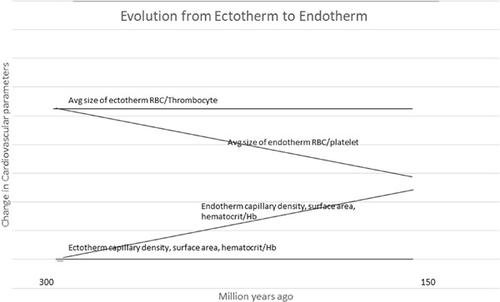当前位置:
X-MOL 学术
›
J. Exp. Zool. B Mol. Dev. Evol.
›
论文详情
Our official English website, www.x-mol.net, welcomes your
feedback! (Note: you will need to create a separate account there.)
The role of the red blood cell and platelet in the evolution of mammalian and avian endothermy
Journal of Experimental Zoology-B: Molecular and Developmental Evolution ( IF 1.8 ) Pub Date : 2019-12-04 , DOI: 10.1002/jez.b.22922 Gerald Soslau 1
Journal of Experimental Zoology-B: Molecular and Developmental Evolution ( IF 1.8 ) Pub Date : 2019-12-04 , DOI: 10.1002/jez.b.22922 Gerald Soslau 1
Affiliation

|
This review presents evidence to support the hypothesis that the reduced O2 during the Permian/Triassic period was the impetus for the evolutionary selection of endothermic animals. The evolution of smaller red blood cells with greater surface areas along with increased: capillary density, capillary surface area, hematocrits, blood pressure, blood flow rates, and shear rates were critical for efficient gas exchange in endothermy. The evolution of the four‐chambered mammalian/avian heart allowed for low pulmonary and high systemic blood pressure. It is proposed that hypoxia‐induced angiogenesis led to increased vascularization in endothermic animals. The increased blood pressure, flow rates, and shear forces likely required changes in hemostatic mechanisms that were met in mammals by the evolution of anucleate platelets. The evolution of mammals and birds occurred in a parallel fashion with further genetic changes to anucleate RBCs/platelets occurring in mammals. Although it is possible that the evolution of endothermy in birds and mammals occurred as two independent events, it is more likely that a common ancestor developed genetic mutations that laid down the road map for parallel alterations of their cardiovascular system in response to environmental pressures. Model systems to support the proposed changes from ectotherm to endotherm were developed from published data. The evolutionary development of endothermy occurred over millions of years with a continuum of genetic alterations that involved skeletal, soft tissue, cardiovascular macrochanges along with numerous molecular alterations. Genetic signals and potential regulators for the evolutionary changes of endothermic blood cells from their bipotential stem cells are also proposed.
中文翻译:

红细胞和血小板在哺乳动物和禽类吸热中的作用
这篇综述提供了支持以下假设的证据:O 2减少在二叠纪/三叠纪时期,这是吸热动物进化选择的动力。随着表面积的增加,较小的红细胞的进化也随之增加:毛细血管密度,毛细血管表面积,血细胞比容,血压,血流速率和剪切速率对于有效的吸热气体交换至关重要。四腔哺乳动物/禽心脏的进化允许低肺和高全身血压。有人提出,低氧诱导的血管生成导致吸热动物的血管生成增加。血压,流速和剪切力的增加可能需要改变止血机制,这在哺乳动物中通过无核血小板的进化得以满足。哺乳动物和鸟类的进化以平行的方式发生,而进一步的遗传变化导致哺乳动物的无核红细胞/血小板发生。尽管鸟类和哺乳动物的吸热进化有可能是两个独立的事件,但一个共同的祖先更有可能发展出基因突变,从而为应对环境压力而平行改变其心血管系统奠定了路线图。从公开的数据开发了支持从外热到内热的拟议变化的模型系统。吸热的进化发展经历了数百万年,伴随着一系列遗传改变,包括骨骼,软组织,心血管大改变以及许多分子改变。
更新日期:2020-04-14
中文翻译:

红细胞和血小板在哺乳动物和禽类吸热中的作用
这篇综述提供了支持以下假设的证据:O 2减少在二叠纪/三叠纪时期,这是吸热动物进化选择的动力。随着表面积的增加,较小的红细胞的进化也随之增加:毛细血管密度,毛细血管表面积,血细胞比容,血压,血流速率和剪切速率对于有效的吸热气体交换至关重要。四腔哺乳动物/禽心脏的进化允许低肺和高全身血压。有人提出,低氧诱导的血管生成导致吸热动物的血管生成增加。血压,流速和剪切力的增加可能需要改变止血机制,这在哺乳动物中通过无核血小板的进化得以满足。哺乳动物和鸟类的进化以平行的方式发生,而进一步的遗传变化导致哺乳动物的无核红细胞/血小板发生。尽管鸟类和哺乳动物的吸热进化有可能是两个独立的事件,但一个共同的祖先更有可能发展出基因突变,从而为应对环境压力而平行改变其心血管系统奠定了路线图。从公开的数据开发了支持从外热到内热的拟议变化的模型系统。吸热的进化发展经历了数百万年,伴随着一系列遗传改变,包括骨骼,软组织,心血管大改变以及许多分子改变。











































 京公网安备 11010802027423号
京公网安备 11010802027423号